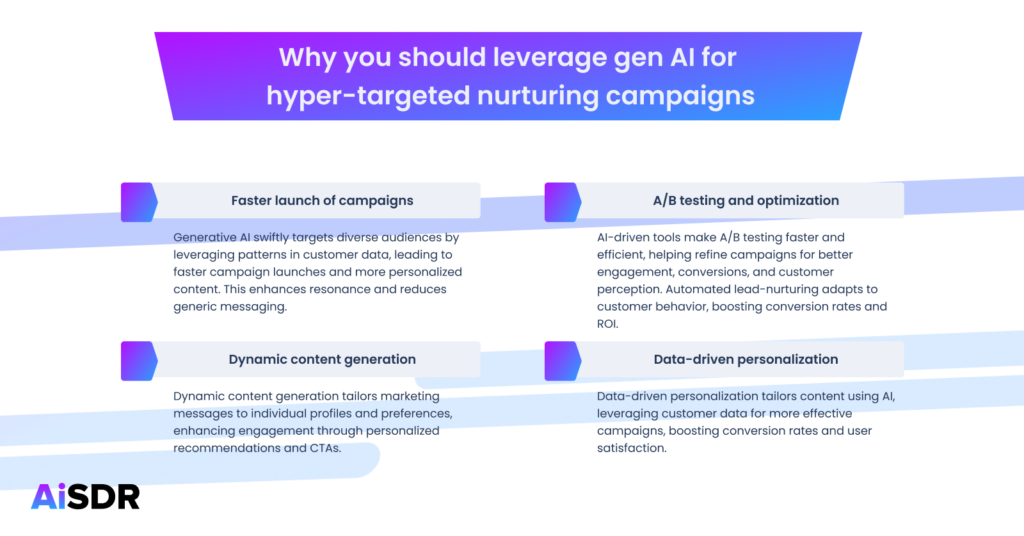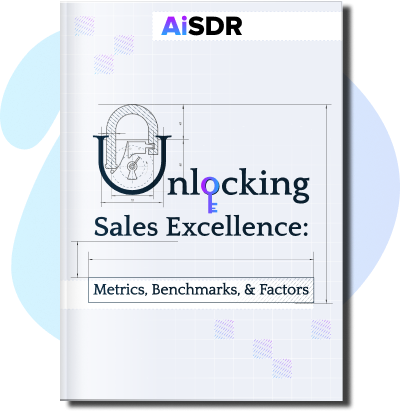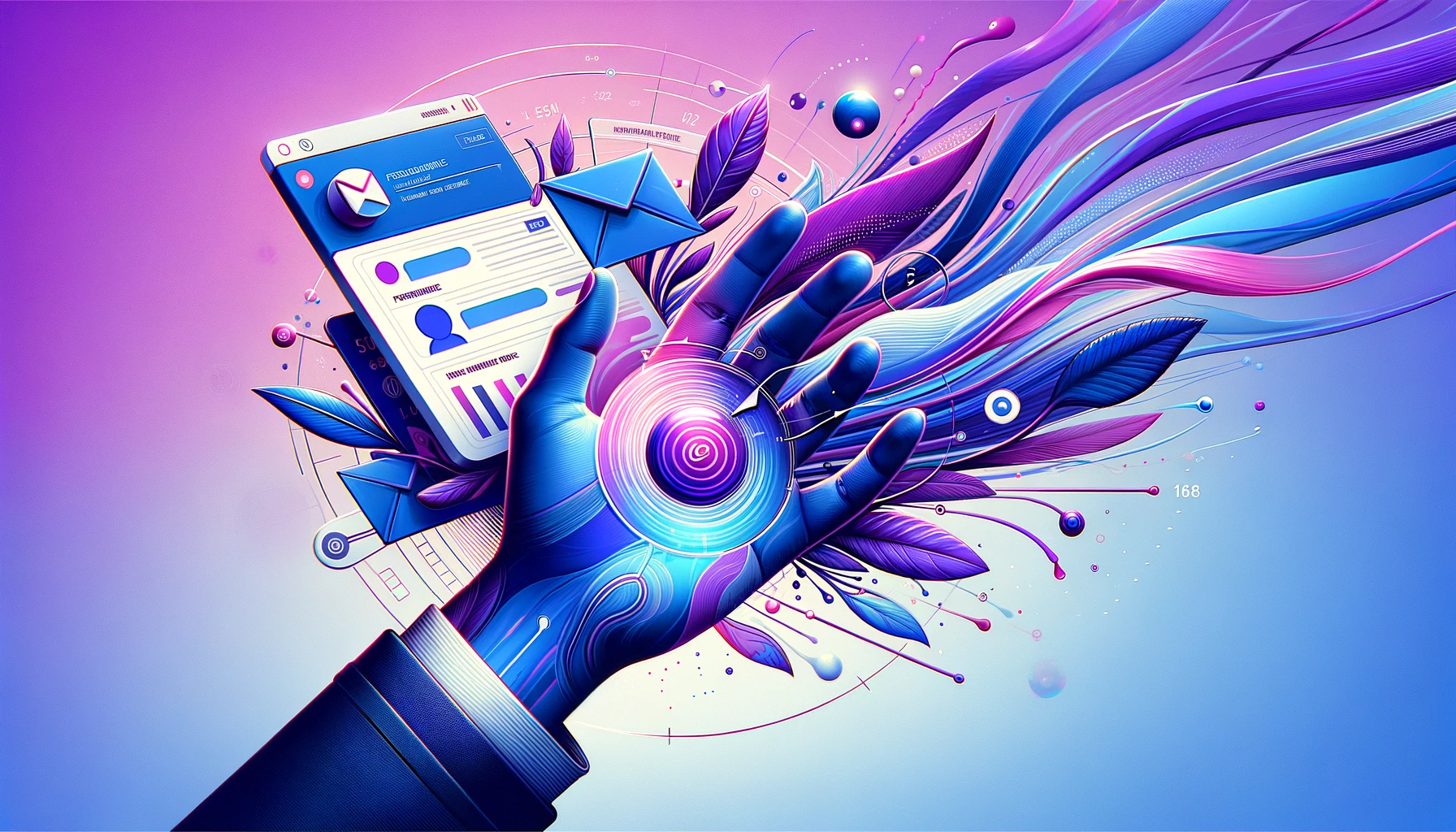Personalization at Scale: Leveraging Generative AI for Hyper-Targeted Nurturing Campaigns

Never read ‘I hope this email finds you well’ in any of your outreach with our personalization insights
What if you could engage your leads with highly relevant messages at the right time and in the most compelling context? This is what generative AI for nurturing campaigns can do — boost prospects’ interest and give you a better chance of converting them.
No matter how good your marketing team is at crafting personalized emails, when the number of leads grows, maintaining the balance between tailored messaging and efficient mass communication becomes a real challenge.
Generative AI models like ChatGPT for marketing can help ensure each interaction feels unique and relevant while reaching a broad audience. It’s no surprise that by 2028, the market for AI in digital marketing is predicted to reach $107.5 billion, a sevenfold boost from 2021 predictions.
Keeping that in mind, let’s explore the factors behind the tremendous growth of generative AI in marketing and its various use cases, benefits, and associated concerns. But before that, we need to uncover why personalization takes the lead in boosting engagement and conversion.
Why personalization is crucial for nurturing campaigns
Imagine entering a restaurant where a master chef crafts personalized dishes that delight each guest’s unique taste preferences.
That’s precisely what tailored marketing emails do for your audience. They serve customized content as if it were a made-to-order meal. These emails cater to receivers’ interests, pain points, and preferences, making them more likely to pay attention, interact, and respond positively.
A McKinsey survey conducted among consumer companies shows that adopting personalization in marketing campaigns can boost a company’s revenue up to 40%, depending on the sector and ability to execute. Hubspot Blog Research also proves message personalization is one of the three most effective marketing campaigns.
Yet, manual personalization in large-scale campaigns can feel like trying to knit sweaters for an entire stadium of people. While the intention is good, it comes with its fair share of challenges:
- Time consumption – Crafting individual messages, tailoring content, and addressing each recipient’s unique needs wastes SDRs’ time, which could be spent on other strategic tasks.
- Sluggish pace – With manual personalization, your campaign’s pace becomes a leisurely stroll instead of a dynamic sprint. This puts you at risk of missing critical moments.
- Bottleneck effect – As the workload piles up, the personalization process can slow the entire campaign’s progress, leading to missed opportunities and delays in reaching your audience.
- “Shoehorned” personalization – Working on a large scale can result in forced and awkward personalization attempts that turn off recipients instead of engaging them.
- Inconsistencies – With so many moving parts, ensuring every email feels cohesive and maintains your brand’s voice and messaging is arduous.
- Human error – In a large-scale manual personalization process, the risk of errors magnifies. Even a tiny mistake can significantly dent your campaign’s credibility.
- Limited scalability – The bigger your campaign, the harder it is to maintain a high level of personalization without significant resources. It’s like trying to individually handwrite notes for an entire stadium. It’s just not feasible.
- Reduced innovation – When tied up in the manual nitty-gritty, your team has less time to brainstorm creative ideas, experiment with new strategies, or adapt to emerging trends. This hampers the company’s ability to stay ahead of the curve.
While manual personalization can be effective in smaller settings, it becomes a complex maze in larger-scale campaigns. Luckily, there’s a way to ease things up. This is where AI-powered marketing tools like AiSDR come into play.
Generative AI offers multiple opportunities for boosting marketing activities, particularly in creating personalized experiences, AI B2B lead generation, B2B lead nurturing, and fixing broken outbound and inbound.
How will generative AI help in marketing?
The benefits of AI in marketing extend beyond specific industries. AI can leave a lasting impact on various sectors and activities, including lead discovery, email outreach and correspondence, and guiding leads along their customer journey.
Since generative AI technology has reached the point where AI-powered automation can significantly reduce heavy employee workloads, organizations are using this opportunity to allow marketing and sales teams to jump on the bandwagon. And many organizations have already adopted this approach, as evidenced by various research findings.
A Statista study in 2023 revealed that 73% of U.S. marketers incorporated generative artificial intelligence tools, including chatbots, into their artificial intelligence lead generation strategies.
Another recent survey conducted by the Boston Consulting Group among CMOs found that 70% of organizations already use GenAI, and 19% are currently testing it. Personalization takes the lead among the use cases, with 67% of respondents exploring the use of generative AI for this purpose.

Enhanced personalization and efficiency
Given the technology’s potential to automate segmentation, transform customer experiences, and provide predictive analytics for insight-based decision-making, organizations are incentivized to explore generative AI.
Generative AI tools like AiSDR empower marketers to optimize resource allocation by:
- Reducing the time and effort required for content production
- Enhancing the quality and diversity of the content
- Personalizing messages and optimizing campaigns based on consumer behavior patterns and preferences
- Generating ideas or inspiration for marketing content by creating mood boards, suggesting news stories, or supplying best practices based on the user’s previous engagement
- Producing human-like text and images that can capture the attention and interest of the audience
For all of these actions, personalization is key. For example, when fed with company-specific data and context, AiSDR and other generative AI tools can function as a super-powered magnifying glass for understanding customers.
Let’s take a closer look at how businesses can use generative AI sales tools to take their nurturing campaigns to a new level of precision and effectiveness.
Let’s take a closer look at how businesses can use generative AI sales tools to take their nurturing campaigns to a new level of precision and effectiveness.
Improved conversions with AI
By leveraging AI lead generation tools to support B2B marketing teams, businesses can increase conversions through the following ways:
- Demand generation:
- Implement chatbots and virtual customer assistants (VCAs) for real-time customer interactions.
- Automate content distribution and personalize responses to enhance lead conversions (Gartner predicts that by 2025, 30% of outbound marketing messages from large organizations will be synthetically generated, up from less than 2% in 2022).
- Predictive lead qualification and guided selling:
- Deploy lead scoring AI to predict customer behavior and personalize engagements.
- Increase lead-to-win conversions with improved opportunity scoring.
- Enhance sales and marketing alignment by integrating interaction data.
- Forecasting:
- Invest in predictive forecasting for insights into expected revenue, revenue shortfalls/excesses, and forecast indicators at the opportunity level.
- Prioritize deals and customers efficiently, reducing costs and boosting revenue.
- Conversation intelligence:
- Leverage AI for analyzing speech and text-based communication across CRM, emails, and call logs.
- Analyze call recordings for coaching opportunities and identify successful marketing strategies.
- Deploy virtual agents for initial customer interactions and follow-ups, improving customer engagement.
- Automate note-taking during client conversations to reduce manual efforts and enhance focus on clients.
AI B2B lead generation in marketing is all about efficiency and engagement, serving as a key driver of higher conversions and revenue growth.
Cost reduction with AI in B2B lead generation
In a landscape where economic uncertainty looms, and businesses are bracing for possible recession, the instinct to tighten marketing budgets seems prudent. Yet, short-term cost-cutting measures may not always align with long-term profitability goals.
Here are some ways for generative AI to help marketers navigate this delicate balance, potentially reducing costs:
- Automated content creation – Generative AI tools can automatically generate content like blog posts, social media updates, and product descriptions. This reduces the need for hiring content creators and lowers content production costs.
- Personalized marketing materials – Marketers can improve conversion rates and optimize ad spend by delivering customized messages to target audiences. This way, marketers can reduce spending and increase revenue, ensuring a stable flow of leads with Gen AI.
- Dynamic creative optimization – Generative AI algorithms can dynamically generate ad creatives based on real-time data and user interactions. This enables marketers to optimize their ad campaigns continuously, minimizing wasted ad spending on underperforming creatives.
- Automated design and layout generation – AI tools can automate the design and layout of website banners, email templates, and print collateral, reducing a graphic designer’s time and potentially accelerating the content creation process.
- Content re-purposing – Generative AI can repurpose existing content into different formats, such as turning blog posts into videos or infographics. This maximizes the value of content assets and reduces the time and resources required to create new content from scratch.
In the end, the more you can reduce the cost of finalizing each new deal, the larger your sales ROI will be.
Hyper-targeted nurturing campaigns
Generative AI emerges as a potent ally for crafting personalized lead nurturing campaigns. It frees marketing from defining strict steps followed over time with set content. Generative AI can take over this task and adjust content based on prospects’ engagement levels, actions, and changing needs in several ways.
Here are several opportunities for AI lead generation tools to elevate your marketing endeavors.
Data-driven personalization
AI algorithms analyze and learn from customer data, including their profiles, past behavior, preferences, and interests. The icing is that marketing AI tools also take customer demographics, location, and other criteria to generate relevant and engaging content for each customer. Such data-driven insights can help marketers create more targeted and effective nurturing campaigns that increase conversion and improve user experience.
Dynamic content generation
Generative AI revolutionizes marketing campaigns by dynamically tailoring output to recipient profiles and preferences. For example:
Generic: “Discover our latest offers!”
Dynamic (based on recipient profile):
“It’s time to prepare for autumn strolls, Jane: exclusive offers await!”
Crucially, generative AI avoids the pitfall of shoehorning by naturally integrating the personalized touch. The content body is equally adaptive, crafting bespoke product recommendations or suggestions that align with the recipient’s preferences or previous search history.
For instance, instead of reminding shoppers of items they looked at but didn’t buy, machine learning in marketing can go one step further and recommend products or services that complement what they’ve already browsed or bought.
Calls-to-action (CTA) also reflect this precision, prompting users to engage in a manner tailored to their needs.
Generic: “Shop now”
Dynamic: “Start exploring your athletic potential, Peter – find your perfect gear now!”
A/B testing and optimization
AI-driven marketing tools allow you to perform A/B testing to compare how different versions of content perform in terms of user engagement, conversions, or other relevant metrics. Unlike manual testing, which can be time-consuming, AI processes data quickly and autonomously, allowing you to iterate quickly and refine campaign elements based on customer perception.
Automating lead-nurturing campaigns based on evolving customer patterns allows you to improve conversion rates and ensure maximum return on investment.
Faster launch of campaigns
Generative AI algorithms find and leverage patterns in customer data to segment and target relevant audiences. This allows tailoring content for diverse sectors and accelerates campaign launches.
Consequently, the synergy between faster copy creation and swift campaign initiation empowers marketing and sales teams to orchestrate more segmented campaigns. This translates to heightened personalization, reduced generic content, and enhanced resonance with recipients.

As we’ve explored how generative AI and marketing hyper-personalization work in practice, let’s pinpoint the outcomes this synergy can deliver.
What are the benefits of hyper-targeted nurturing campaigns?
Here are several benefits of setting up campaigns that capitalize on the potential of generative AI and marketing hyper-personalization.
- Increased engagement and conversion rates – Inducing personalization allows you to deliver marketing messages relevant to customers’ wants and needs. HubSpot study states that personalized CTAs based on the user’s behavior or situation can have 202% higher conversion rates than generic ones.
- Lower campaign costs – AI-powered lead nurturing campaigns help businesses save costs by increasing efficiency and optimizing marketing resources. A Harvard Business Review (HBR) study states companies that use AI in sales to personalize customer interactions can reduce customer acquisition costs by up to 50% and increase marketing spending efficiency by up to 30%.
- Higher sales and profit – Tailoring your messaging to specific segments results in a better return on investment as your efforts are more focused and effective. HBR study states companies that use AI to personalize customer interactions faced a 6% to 10% increase in net incremental revenue.
To achieve these benefits, it’s crucial to gather accurate customer data, segment your audience effectively, create compelling and tailored content, and use marketing and sales automation tools to deliver messages at the right time and through the right channels.
As you can see, using generative AI for marketing campaigns can be highly effective when adopted right. To build successful nurturing campaigns, you also need to know potential challenges that may come along the way.
Overcoming challenges and concerns
Adopting conversational AI for sales and marketing isn’t a magic button to put your content strategy on autopilot. GenAI tools like ChatGPT for marketing can introduce significant security and reputational risks without human supervision (e.g., made-up facts, duplicated content, intellectual property risks, etc.)
So, how can AI in sales and marketing work without threatening your company’s reputation?
The key is the data you feed your AI marketing tool. To prevent generic or robotic content while ensuring accurate output, carry out these steps:
- Feed your AI sales tool with zero-party and first-party data
- Incorporate established brand guidelines
- Include diverse data sources (different marketing materials)
- Perform human oversight and refine AI’s output
- Create clear and well-formulated prompts
Through these mechanisms, generative AI can become a powerful tool for producing authentic, engaging, and contextually appropriate content aligned with your brand’s voice and values.
How can AI help reach marketing goals quickly?
Leveraging gen AI is paramount to achieving your goals, especially those concerning lead generation and nurturing. Here are some highlights on generating leads with GenAI, together with some successful AI-related use cases from industry giants.
Leverage AI for Enhanced Lead Nurturing
You can utilize AI lead generation tools to streamline the progression of inbound leads through your marketing funnel. These tools can effectively manage outbound email campaigns and continuously refine and adapt strategies based on evolving customer behaviors and preferences.
The proof of that statement is Airbnb’s experience of using AI algorithms to personalize its user communication based on their browsing history, past bookings, and preferences. By sending targeted emails and notifications about relevant listings and travel experiences, Airbnb effectively nurtures leads and encourages users to complete bookings, thereby driving conversion and revenue growth.
Apply AI-Powered Predictive Analytics for Hyper-Personalized Campaigns
By analyzing vast amounts of customer data, AI algorithms can identify behavioral patterns and predict the future actions of their ideal customers, allowing marketers to tailor personas, outreach, and offers to individual preferences.
This level of personalization enhances customer engagement, increases conversion rates, drives outbound and inbound outreach, and accelerates the customer acquisition process — artificial intelligence for lead generation at its best.
The classic example of efficient use of predictive analytics fueled by AI is Amazon, with its highly personalized shopping experience. The recommendation engine analyzes customer behavior and past purchases to suggest relevant products, increasing sales and customer satisfaction.
Use AI for Data-Driven Insights
Harness the capabilities of AI for data analysis and insights generation. By leveraging AI algorithms to interpret vast amounts of customer data, marketers can uncover valuable patterns and trends, enabling them to make informed decisions and refine their marketing strategies.
You’ve probably heard of Netflix leveraging AI for data analysis to gain insights into viewer preferences and behavior. This data then informs content creation and recommendation algorithms, ultimately improving user satisfaction and retention.
Personalize and scale your nurturing with generative AI
As AI advances, its integration into personalized marketing is set to reshape the landscape of customer engagement and brand communication. It can help businesses successfully scale their marketing campaigns and quickly craft hundreds of hyper-personalized emails with offerings based on individual customer behavior, persona, and purchase history.
AiSDR can assist marketing teams that face challenges in progressing inbound leads through their funnel without the assistance of SDRs. It can manage outbound email campaigns and make ongoing refinement and adaptation based on evolving customer behaviors and preferences.
Book a demo to find out how AiSDR will optimize costs and boost conversion with hyper-personalized email campaigns.
FAQs
What is hyper-personalization in AI?
Hyper-personalization involves using algorithms to create highly relevant and customized interactions with individual users based on their past experiences, preferences, pain points, geographical location, and other factors.
What is the benefit of hyper-personalization in marketing?
Hyper-personalization can enhance customer experiences, increase engagement, and improve conversion rates. Marketers can build stronger relationships and drive better results by delivering content, recommendations, and offers that resonate deeply with each individual’s preferences and behaviors.
What is an example of hyper-personalization?
Sending an email to a customer with product recommendations based on their past purchases, browsing history, demographic information, and even real-time behavior on the website is a great example of hyper-personalization. Such emails can include tailored subject lines, content, and calls to action, catering to customer needs and preferences.
How do you implement hyper-personalization?
Implementing hyper-personalization in sales and marketing campaigns requires a strategic approach and the use of advanced technology to employ dynamic content generation. Personalized email campaigns, automated sales funnel tools, product recommendations, and website personalization based on real-time behavior can help companies drive engagement and conversions.











